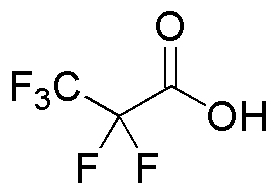Pentafluoropropionic acid is widely utilized in research focused on:
- Fluorinated Polymer Production: It serves as a key building block in creating fluorinated polymers, which are known for their high thermal stability and chemical resistance, making them ideal for applications in coatings and sealants.
- Analytical Chemistry: This compound is used as a derivatizing agent in mass spectrometry, enhancing the detection and analysis of various organic compounds, which is crucial for researchers in environmental and pharmaceutical fields.
- Pharmaceutical Development: It plays a role in the synthesis of fluorinated pharmaceuticals, which often exhibit improved metabolic stability and bioavailability compared to their non-fluorinated counterparts, benefiting drug formulation processes.
- Surface Modification: Pentafluoropropionic acid is applied in modifying surfaces to enhance hydrophobicity, which is particularly useful in the electronics and automotive industries for improving durability and performance.
- Research in Green Chemistry: Its use in developing eco-friendly solvents and reagents aligns with the principles of green chemistry, promoting sustainable practices in chemical manufacturing and reducing environmental impact.
General Information
Properties
Safety and Regulations
Applications
Pentafluoropropionic acid is widely utilized in research focused on:
- Fluorinated Polymer Production: It serves as a key building block in creating fluorinated polymers, which are known for their high thermal stability and chemical resistance, making them ideal for applications in coatings and sealants.
- Analytical Chemistry: This compound is used as a derivatizing agent in mass spectrometry, enhancing the detection and analysis of various organic compounds, which is crucial for researchers in environmental and pharmaceutical fields.
- Pharmaceutical Development: It plays a role in the synthesis of fluorinated pharmaceuticals, which often exhibit improved metabolic stability and bioavailability compared to their non-fluorinated counterparts, benefiting drug formulation processes.
- Surface Modification: Pentafluoropropionic acid is applied in modifying surfaces to enhance hydrophobicity, which is particularly useful in the electronics and automotive industries for improving durability and performance.
- Research in Green Chemistry: Its use in developing eco-friendly solvents and reagents aligns with the principles of green chemistry, promoting sustainable practices in chemical manufacturing and reducing environmental impact.
Documents
Safety Data Sheets (SDS)
The SDS provides comprehensive safety information on handling, storage, and disposal of the product.
Product Specification (PS)
The PS provides a comprehensive breakdown of the product’s properties, including chemical composition, physical state, purity, and storage requirements. It also details acceptable quality ranges and the product's intended applications.
Certificates of Analysis (COA)
Search for Certificates of Analysis (COA) by entering the products Lot Number. Lot and Batch Numbers can be found on a product’s label following the words ‘Lot’ or ‘Batch’.
*Catalog Number
*Lot Number
Certificates Of Origin (COO)
This COO confirms the country where the product was manufactured, and also details the materials and components used in it and whether it is derived from natural, synthetic, or other specific sources. This certificate may be required for customs, trade, and regulatory compliance.
*Catalog Number
*Lot Number
Safety Data Sheets (SDS)
The SDS provides comprehensive safety information on handling, storage, and disposal of the product.
DownloadProduct Specification (PS)
The PS provides a comprehensive breakdown of the product’s properties, including chemical composition, physical state, purity, and storage requirements. It also details acceptable quality ranges and the product's intended applications.
DownloadCertificates of Analysis (COA)
Search for Certificates of Analysis (COA) by entering the products Lot Number. Lot and Batch Numbers can be found on a product’s label following the words ‘Lot’ or ‘Batch’.
*Catalog Number
*Lot Number
Certificates Of Origin (COO)
This COO confirms the country where the product was manufactured, and also details the materials and components used in it and whether it is derived from natural, synthetic, or other specific sources. This certificate may be required for customs, trade, and regulatory compliance.


